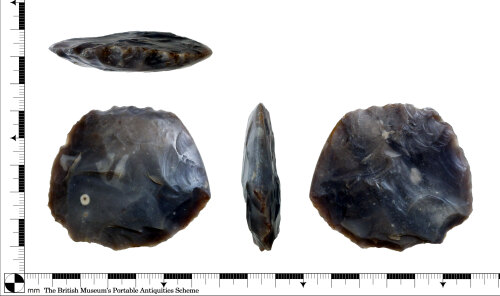The traditional story of Four Marks goes that the parish (which was created in 1932) had little going on prior to the late 1800s. With no more than around five farmsteads during the 1700s the village was sparsely settled to say the least, which was due to a number of reasons. Being on a ridge between two watersheds meant water access was difficult leaving local agriculture reliant on small dewponds which often dried up. Stony and hilly fields meant ploughing was a chore and the fields weren’t the most fertile. These factors didn’t necessarily curse the area, it was more a matter of better soil and water access being available elsewhere and there were next to no redeeming qualities. This meant that the land of Four Marks was the common fields for the neighbouring four parishes, hence its name. Larger scale settlement didn’t occur until advances in water engineering in the 1900s.
However, this wasn’t always the case. About 5,000 years ago in the Neolithic- ‘New Stone Age’, Hampshire was full of hotspots of activity. Settlements dotted the banks of streams and rivers, deep mines provided the ever vital flint and the first agricultural fields and domesticated animals fed the neolithic dwellers. Although no archaeological evidence of houses has been found yet in Hampshire, finds of pottery and high concentrations of flints clearly show long term activity, i.e., settlement.
Four Marks was one of those hotspots. The landscape of Europe, let alone Hampshire, looked very different 5,000 years ago. The local geography would have been covered mostly by woodland which were interspersed with meadows and man-made clearings. The wooded landscape would have been partially maintained through coppicing and sometimes with fire. Streams, which have long since run dry, flowed from Swelling Hill Pond, (then a spring) and fed east-running tributaries which joined to the river Wey near Alton. These streams not only provided plenty of water for humans but also for red deer, badgers and foxes. Although hunting and fishing was still part of the human diet, the importance of domesticated crops and animals was far more significant. We know as a matter of fact that this was the case in neolithic Four Marks as a sickle and sickle related flint tools were found in the west of the parish in the last century. This may seem quite insignificant, but agriculture was the birth of civilisation and its spread across Europe from modern day Iran and Iraq along with other technologies was a revolution.
Over the years many artefacts made of flint and stone dating from the middle stone age- Mesolithic (around 12,000 years ago) to the early bronze age (3,500 years ago) have been found in the vicinity. These flint finds implicate Four Marks as being settled and managed by prehistoric humans for thousands of years. The finds range from crude scrapers, made to clean animal hides and to carve wood (if you like the single use plastic knives of their time). At the other end of the spectrum are highly valued objects like polished axe heads (found in Four Marks 1957), polished knives (found in Ropley 2021), and maces (found in Medstead 1961). Some of these status symbols suggest a ritualistic society as the items’ looks often outweigh their usefulness. They would have taken hours upon hours to create by slowly grinding down the unfinished stone on a rough surface into smooth and attractive tools. Evidence for this process- a sandstone slab with clear wear marks was found in Ropley last year.
It is hard to say exactly how the settlement in Four Marks looked but we know that in these times rectangular wooden huts were in vogue. One of these huts may have stood near to the banks of one of the long since dried up streams- the immediate area would have been littered with flint flakes, the biproduct of flintknapping. Thanks to the plentiful supply of water and the stoney soil (which back then was very much a blessing and not the hurdle it came to be later), Four Marks was an ideal location for these Stone Age people. The stoney soil provided flints for tools and rounded pebbles to be used as hammerstones needed to work or ‘knap’ the larger flint nodules to create tools.
Flint was such an important resource to the neolithic peoples that mines were opened so the flint could be extracted. Near Four Marks an overgrown stone age flint mine, recorded first in 1945 gives a good example of how this was carried out. A narrow shaft was dug down vertically, in this case over 4 meters deep, with picks made from hafted flint or a antler. An individual, (possibly a child), would then have dug into the seams of flints outwards creating an upside down “T” shape in cross section. Flints would have also been found naturally on the surface as is still the case today, those pesky flint nodules bringing joy to the prehistoric humans and not a tripping hazard as we might view them today.
These artefacts and features portray a vivid picture of our landscape several millennia ago as being busy with human settlement at the dawn of civilisation. It is a thought-provoking contradiction for some of the oldest archaeology in Hampshire to be found in one of its youngest villages.










No Comments
Add a comment about this page